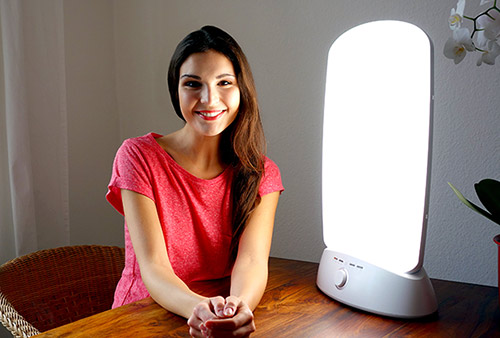 Are you one of the millions of Americans diagnosed with seasonal affective disorder, or SAD? Seasonal affective disorder is a form of temporary depression that tends to occur in the fall and winter when the days are shorter, and there’s less daylight. A treatment that I’ve been using for years is a light therapy box. I use one daily, which really helps with the winter blues!
Are you one of the millions of Americans diagnosed with seasonal affective disorder, or SAD? Seasonal affective disorder is a form of temporary depression that tends to occur in the fall and winter when the days are shorter, and there’s less daylight. A treatment that I’ve been using for years is a light therapy box. I use one daily, which really helps with the winter blues!
People with SAD usually become depressed when the days start getting shorter, and there’s less sunshine available. However, many don’t realize that they experience depression during the winter months. Studies have proven that a lack of natural sunlight will disrupt our internal clocks. Another cause of SAD is the lack of natural vitamin D our bodies produce. Vitamin D production is triggered by sunlight exposure, so a lack of sunlight causes our bodies to create less of this important vitamin.
But SAD is more than just the “winter blues.” Like major depression, SAD can cause severe symptoms. However, also like major depression, SAD can be treated.
If you think you may suffer from SAD, talk to your doctor or a mental health specialist about your concerns. Treatments like psychotherapy, antidepressant medications, vitamin D, and light therapy can help many people with SAD. Make sure to talk to your medical professional about which treatment, or combination of treatments, is best for you.
The Importance of the Circadian Rhythm
The natural internal process that resets your internal biological clock approximately every 24 hours is called the circadian rhythm. If you feel tired, depressed, or just plain “out of sync,” you can get significant relief by resetting this personal internal clock. Being exposed to natural sunlight triggers the area of the brain that controls the circadian rhythm, which resets these processes.
The circadian rhythm is responsible for our sleep-wake cycle, as well as many other biological processes and behavioral changes that our bodies go through in each 24-hour cycle. Certain types of artificial light exposure that mimic sunlight can “trick” your body’s circadian rhythm into resetting your internal clock, restoring these processes to normal and alleviating your symptoms of SAD.
Bright Ideas for the Treatment of SAD
Since scientists have linked the symptoms of SAD closely with lower exposure to light, increasing your light levels can help. For example, try taking your breaks outdoors when the sun comes out from behind the clouds. Or move your desk at work closer to a window.
Another treatment you should try is a light therapy box, a lamp that radiates a very bright, white light, which serves like sunlight. Most people using light therapy feel some relief within one or two weeks of starting treatment.
There are many options available when selecting a light therapy device. The devices vary in intensity, and some even offer adjustable brightness. Check out CNET’s list of The 7 Best Light Therapy Lamps for 2023 to get recommendations that their team has tested and evaluated. Their list includes options ranging from $40 to $261, making this an affordable form of therapy for most. Light therapy is also very safe for most people: light boxes are about 20 times brighter than ordinary indoor light and filter out potentially damaging UV light.
Here are four valuable tips for using light therapy:
- Get the right light. Look for a light box with at least a 10,000 lux exposure. “Lux” is a method of measuring light intensity. For reference, a bright sunny day is 50,000 lux or more.
- Take your time. There’s no need to sit by your lamp for hours! Instead, try to absorb light from your lamp for around half an hour daily. You might try getting those 30 minutes in using several sittings when you’re just starting out with light therapy.
- Begin in the morning. To start your day off right, sit by your lamp before 10 am.
- Avoid staring. Since your light box will be very bright, don’t stare directly at the light! Situate your box to the side and about a foot away from you.
There are very few side effects reported from using light therapy lamps. The most common side effects include eye strain, mild nausea, headaches, and irritability. However, if you experience any side effects, they should be mild and not last very long.
If you have a family history of macular degeneration, exposure to light therapy over the years may increase your risk. Also, some medications, such as tetracycline, make your skin more light-sensitive. Talk with your doctor if any of these apply to you.
How Long Does It Take For Light Therapy To Work?
You should start to feel results from light therapy sessions within a few days and no longer than two weeks. If you feel the need to change your treatment process, try only to change one part in any two-week period. Be sure to share all the information on what you’re doing with your doctor and ask for their advice if necessary.
Since every light box or therapy lamp is different, make sure to read all of the information and instructions before using it, especially about the distance to sit from it. Typically, people will begin light therapy sessions at just 30 minutes daily, increasing if necessary. To get the full benefits of light therapy, do it at the same time each day, ideally about an hour after waking up in the morning. Using your light box between 6 and 9 am is best.
If you suffer from a mental health issue, such as another form of depression, remember to always consult your psychiatrist or therapist before starting a new treatment, like light therapy. Likewise, ask your medical professional for advice if you have symptoms that do not let up after treatment.
